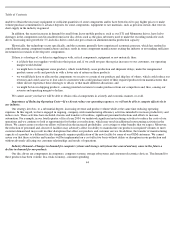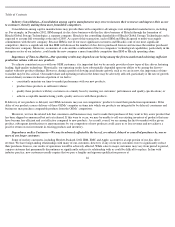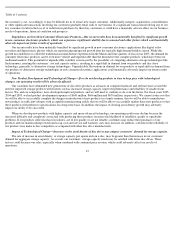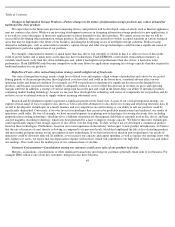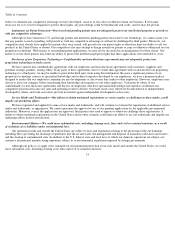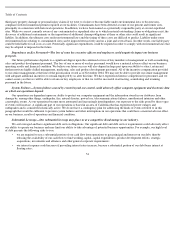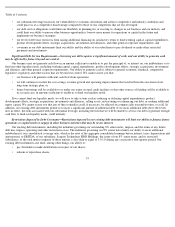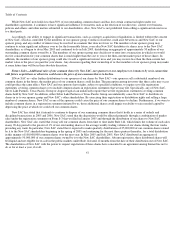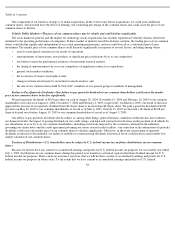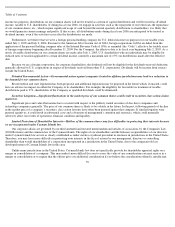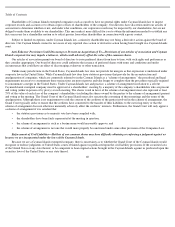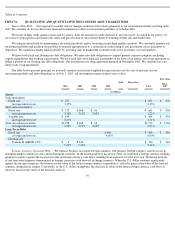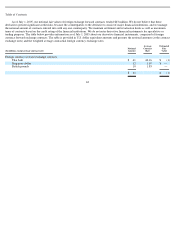Seagate 2004 Annual Report Download - page 56
Download and view the complete annual report
Please find page 56 of the 2004 Seagate annual report below. You can navigate through the pages in the report by either clicking on the pages listed below, or by using the keyword search tool below to find specific information within the annual report.
Table of Contents
reduce or eliminate any competitive advantage we have developed, cause us to lose sales or otherwise harm our business. If it became
necessary for us to resort to litigation to protect these rights, any proceedings could be burdensome and costly, and we may not prevail.
Limitations on Patent Protection—Our issued and pending patents may not adequately protect our intellectual property or provide us
with any competitive advantage.
Although we have numerous U.S. and foreign patents and numerous pending patents that relate to our technology, we cannot assure you
that any patents, issued or pending, will provide us with any competitive advantage or will not be challenged by third parties. Moreover, our
competitors may already have applied for patents that, once issued, will prevail over our patent rights or otherwise limit our ability to sell our
products in the United States or abroad. Our competitors also may attempt to design around our patents or copy or otherwise obtain and use our
proprietary technology. With respect to our pending patent applications, we may not be successful in securing patents for these claims. Our
failure to secure these patents may limit our ability to protect the intellectual property rights that these applications were intended to cover.
Disclosure of our Proprietary Technology—Confidentiality and non-disclosure agreements may not adequately protect our
proprietary technology or trade secrets.
We have entered into confidentiality agreements with our employees and non-disclosure agreements with customers, suppliers and
potential strategic partners, among others. If any party to these agreements were to violate their agreement with us and disclose our proprietary
technology to a third party, we may be unable to prevent the third party from using this information. Because a significant portion of our
proprietary technology consists of specialized knowledge and technical expertise developed by our employees, we have a program in place
designed to ensure that our employees communicate any developments or discoveries they make to other employees. However, employees may
choose to leave our company before transferring their knowledge and expertise to our other employees. Violations by others of our
confidentiality or non-disclosure agreements and the loss of employees who have specialized knowledge and expertise could harm our
competitive position and cause our sales and operating results to decline. Our trade secrets may otherwise become known or independently
developed by others, and trade secret laws provide no remedy against independent development or discovery.
Service Marks and Trademarks—Our failure to obtain trademark registrations or service marks, or challenges to those marks, could
impede our marketing efforts.
We have registered and applied for some service marks and trademarks, and will continue to evaluate the registration of additional service
marks and trademarks, as appropriate. We cannot guarantee the approval of any of our pending applications by the applicable governmental
authorities. Moreover, even if the applications are approved, third parties may seek to oppose or otherwise challenge these registrations. A
failure to obtain trademark registrations in the United States and in other countries could limit our ability to use our trademarks and impede our
marketing efforts in those jurisdictions.
Environmental Matters—We could incur substantial costs, including cleanup costs, fines and civil or criminal sanctions, as a result
of violations of or liabilities under environmental laws.
Our operations inside and outside the United States are subject to laws and regulations relating to the protection of the environment,
including those governing the discharge of pollutants into the air and water, the management and disposal of hazardous substances and wastes,
and the cleanup of contaminated sites. In addition to the U.S. federal, state and local laws to which our domestic operations are subject, our
extensive international manufacturing operations subject us to environmental regulations imposed by foreign governments.
Although our policy is to apply strict standards for environmental protection at our sites inside and outside the United States, we could
incur substantial costs, including cleanup costs, fines and civil or criminal sanctions,
53



